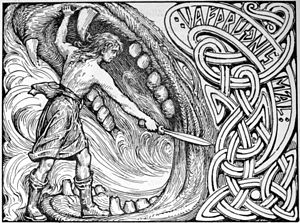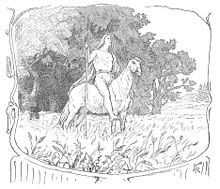Norse deity
 A depiction of Viðarr stabbing Fenrir while holding his jaws apart by
W. G. Collingwood
, 1908, inspired by the
Gosforth Cross
A depiction of Viðarr stabbing Fenrir while holding his jaws apart by
W. G. Collingwood
, 1908, inspired by the
Gosforth Cross
In
Norse mythology
,
Viðarr
(
Old Norse
:
[?wiːð?rː]
, possibly "wide ruler",
[1]
sometimes
anglicized
as
Vidar
,
Vithar
,
Vidarr
, and
Vitharr
) is a
god
among the
Æsir
associated with vengeance. Viðarr is described as the
son of Odin
and the
jotunn
Griðr
and is foretold to avenge his father's death by killing the wolf
Fenrir
at
Ragnarok
, a conflict he is described as surviving. Viðarr is attested in the
Poetic Edda
, compiled in the 13th century from earlier traditional sources, the
Prose Edda
, written in the 13th century by
Snorri Sturluson
, and is interpreted as depicted with Fenrir on the
Gosforth Cross
. A number of theories surround the figure, including theories around potential ritual silence and a
Proto-Indo-European
basis.
Attestations
[
edit
]
 A depiction of Viðarr on horseback by
Lorenz Frølich
, 1895
A depiction of Viðarr on horseback by
Lorenz Frølich
, 1895
Poetic Edda
[
edit
]
In the
Poetic Edda
, Viðarr is mentioned in the poems
Voluspa
,
Vafthrudnismal
,
Grimnismal
, and
Lokasenna
.
In stanzas 54 and 55 of the poem
Voluspa
, a
volva
tells Odin that his son Viðarr will avenge Odin's death at Ragnarok by stabbing Fenrir in the heart:
- Then comes Sigfather's | mighty son,
- Vithar, to fight | with the foaming wolf;
- In the giant's son | does he thrust his sword
- Full to the heart: | his father is avenged.
[2]
In stanzas 51 and 53 of
Vafthrudnismal
,
Vafþruðnir
states that Viðarr and his brother
Vali
will both live in the "temples of the gods" after
Surtr
's fire has ceded and that Viðarr will avenge the death of his father, Odin, by sundering the cold jaws of Fenrir in battle:
- Stanza 51:
- "In the gods' home Vithar | and Vali shall dwell,
- When the fires of Surt have sunk;
- Mothi and Magni | shall Mjollnir have
- When Vingnir falls in fight."
[3]
|
- Stanza 53:
- "The wolf shall fell | the father of men,
- And this shall Vithar avenge;
- The terrible jaws | shall he tear apart,
- And so the wolf shall he slay."
[3]
|
In stanza 17 of
Grimnismal
, during Odin's visions of various dwelling places of the gods, he describes Viðarr's (anglicized as "Vidar") residence:
- Brushwood grows and high grass
- widely in Vidar's land
- and there the son proclaims on his horse's back
- that he's keen to avenge his father.
[4]
According to
Lokasenna
,
Loki
rebukes the gods at the start of the poem for not properly welcoming him to the feast at Ægir's hall. In stanza 10, Odin finally relents to the rules of hospitality, urging Viðarr to stand and pour a drink for the quarrelsome guest. Viðarr follows his orders. Loki toasts the Æsir before beginning his
flyting
.
[5]
Prose Edda
[
edit
]
Viðarr is referenced in the
Prose Edda
books
Gylfaginning
and
Skaldskaparmal
.
 A depiction of Viðarr defeating Fenrir by Lorenz Frølich, 1895
A depiction of Viðarr defeating Fenrir by Lorenz Frølich, 1895
Viðarr is referenced in the book
Gylfaginning
in chapters 29, 51, and 53. In chapter 29, Viðarr is introduced by the enthroned figure of High as "the silent god" with a thick shoe, that he is nearly as strong as the god
Thor
, and that the gods rely on him in times of immense difficulties.
[6]
In chapter 51, High foretells that, during Ragnarok, the wolf
Fenrir
will devour Odin, and Viðarr will avenge him by stepping down with one foot on the lower jaw of the monster, grabbing his upper jaw in one hand and tearing his mouth apart, killing him. Viðarr's "thick shoe" is described as consisting of all the extra leather pieces that people have cut from their own shoes at the toe and heel, collected by the god throughout all time.Therefore, anyone who is concerned enough to give assistance to the gods should throw these pieces away.
[7]
According to some mythologists, he owed this peculiar footgear to his mother Grid, who, knowing that he would be called upon to fight against fire on the last day, designed it as a protection against the fiery element, as her iron gauntlet had shielded Thor in his encounter with Geirrod.
[8]
In chapter 54, following Ragnarok and the rebirth of the world, it is told that Viðarr along with his brother
Vali
will have survived both the swelling of the sea and the fiery conflagration unleashed by
Surtr
, completely unharmed, and shall thereafter dwell on the field
Iðavollr
, "where the city of
Asgard
had previously been".
[9]
According to
Skaldskaparmal
, Viðarr was one of the twelve presiding male gods seated in their thrones at a banquet for the visiting
Ægir
.
[10]
At a point in dialogue between the
skaldic
god
Bragi
and Ægir,
Snorri
himself begins speaking of the myths in
euhemeristic
terms and states that the historical equivalent of Viðarr was the
Trojan
hero
Aeneas
who survived the
Trojan War
and went on to achieve "great deeds".
[11]
Later in the book, various
kennings
are given for Viðarr, including again the "silent
As
", "possessor of the iron shoe", "enemy and slayer of
Fenrisulf
", "the gods' avenging As", "father's homestead-inhabiting As", "son of Odin", and "brother of the Æsir".
[12]
In the tale of the god
Thor
's visit to the hall of the
jotunn
Geirrod
, Griðr is stated as the mother of "Viðarr the Silent" who assists Thor in his journey.
[13]
In chapter 33, after returning from Asgard and feasting with the gods, Ægir invites the gods to come to his hall in
three
months. Fourteen gods make the trip to attend the feast, including Viðarr.
[14]
In chapter 75, Viðarr's name appears twice in a list of Æsir.
[15]
Archaeological record
[
edit
]
 Detail of Gosforth Cross, artist unknown, 1913
Detail of Gosforth Cross, artist unknown, 1913
The mid-11th century
Gosforth Cross
, located in
Cumbria
, England, has been described as depicting a combination of scenes from the Christian
Judgement Day
and the pagan Ragnarok.
[16]
The cross features various figures depicted in
Borre style
, including a man with a spear facing a monstrous head, one of whose feet is thrust into the beast's forked tongue and on its lower jaw, while a hand is placed against its upper jaw, a scene interpreted as Viðarr fighting Fenrir.
[16]
The depiction has also been theorized as a metaphor for Jesus' defeat of Satan.
[17]
Theories
[
edit
]
 A depiction of Viðarr and Vali by
Axel Kulle
(1846?1908), 1892
A depiction of Viðarr and Vali by
Axel Kulle
(1846?1908), 1892
Theories have been proposed that Viðarr's silence may derive from a ritual silence or other abstentions which often accompany acts of vengeance, as for example in
Voluspa
and
Baldrs draumar
when Vali, conceived for the sole purpose of avenging
Baldr
's death, abstains from washing his hands and combing his hair "until he brought Baldr's adversary to the funeral pyre".
[18]
Parallels have been drawn between chapter 31 of
Tacitus
' 1st century
CE
work
Germania
where Tacitus describes that members of the
Chatti
, a
Germanic tribe
, may not shave or groom before having first slain an enemy.
[19]
Dumezil
[
edit
]
Georges Dumezil
theorized that Viðarr represents a cosmic figure from an archetype derived from the
Proto-Indo-Europeans
.
[20]
Dumezil stated that he was aligned with both vertical space, due to his placement of his foot on the wolf's lower jaw and his hand on the wolf's upper jaw, and horizontal space, due to his wide step and strong shoe, and that, by killing the wolf, Viðarr keeps the wolf from destroying the cosmos, and the cosmos can thereafter be restored after the destruction resulting from
Ragnarok
.
[20]
Dumezil thus conceives of Viðarr as a spatial god. Dumezil substantiates his claim with the text of the
Lokasenna
, in which Viðarr, trying to mediate the dispute with Loki, urges the other Aesir to "grant Loki his space" at the feasting table. Dumezil argues that this play on Viðarr's spatiality would have been understood by an audience familiar with the god, an interpretation further warranted by his reading of the Lokasenna as being in significant part a book of puns and word plays about the different Aesir.
Dumezil also suggests that Viðarr's spatiality is seen in the Vishnu of the Vedic traditions, both etymologically (the
Vi
- root) and mythologically, citing the story of
Bali and Vishnu
. In this legend,
Vishnu
(in the form of
Vamana
) tricks the malevolent king Bali, who has secured dominion over the whole Earth, by making Bali promise to grant Vamana all the land he can cover in three paces. Vamana turns himself into a giant and strides across all of heaven and Earth, taking Bali's head and granting him immortality in lieu of taking the last pace.
Dumezil theorizes that these myths of Fenrir vs. Viðarr and Bali vs. Vishnu may have a common origin in an Indo-European god of spatiality, similar but distinct from the hypothetical framing or entry / exit god that spawned
Janus
and
Heimdallr
.
[20]
Notes
[
edit
]
- ^
Orchard (1997:174?175).
- ^
Bellows (1923:23)
- ^
a
b
Bellows (1923:82-83)
- ^
Larrington (1999:54).
- ^
Larrington (1999:86).
- ^
Byock (2006:37).
- ^
Byock (2006:73).
- ^
"Myths of the Norsemen: From the Eddas and Sagas"
.
- ^
Byock (2006:77).
- ^
Faulkes (1995:59).
- ^
Faulkes (1995:66).
- ^
Faulkes (1995:76).
- ^
Faulkes (1995:82).
- ^
Faulkes (1995:95).
- ^
Faulkes (1995:156?157).
- ^
a
b
Pluskowski (2004:158).
- ^
Schapiro (1980:264, note 66).
- ^
Lindow (2001:312?313).
- ^
Lindow (2001:311).
- ^
a
b
c
Lindow (2001:314) referencing Dumezil, Georges (1965). "Le dieu scandinave Viðarr" collected in
Revue de l'histoire des religions
168, pages 1?13.
Wikimedia Commons has media related to
Viðarr
.
References
[
edit
]
- Bellows, Henry Adams
(1923).
The Poetic Edda
.
American-Scandinavian Foundation
.
- Byock, Jesse (Trans.) (2006).
The Prose Edda
.
Penguin Classics
.
ISBN
0140447555
- Faulkes, Anthony (Trans.) (1995).
Edda
.
Everyman
.
ISBN
0-4608-7616-3
- Dumezil, Georges. "
Le dieu Scandinave Vidarr
". In:
Revue de l'histoire des religions
, tome 168, n°1, 1965. pp. 1-13.
doi
:
10.3406/rhr.1965.8204
.
- Larrington, Carolyne (Trans.) (1999).
The Poetic Edda
.
Oxford World's Classics
.
ISBN
0192839462
- Lindow, John
(2001).
Norse Mythology: A Guide to the Gods, Heroes, Rituals, and Beliefs
.
Oxford University Press
.
ISBN
0-19-515382-0
- Orchard, Andy (1997).
Dictionary of Norse Myth and Legend
.
Cassell
.
ISBN
0 304 34520 2
- Pluskowski, Aleks. "Apocalyptic Monsters: Animal Inspirations for the Iconography of Medieval Northern Devourers" as collected in: Bildhauer, Bettina. Mills, Robert (2004).
The Monstrous Middle Ages
.
University of Toronto Press
.
ISBN
0802086675
- Schapiro, Meyer
(1980).
Cain's Jaw-Bone that Did the First Murder
, Selected Papers, volume 3, Late Antique, Early Christian and Mediaeval Art. Chatto & Windus, London,
ISBN
0701125144
.
JSTOR
.
|
|---|
|
| |
|---|
| Locations
| | Underworld
| |
|---|
| Rivers
| |
|---|
| Other locations
| |
|---|
|
|---|
| Events
| |
|---|
| Sources
| |
|---|
| Society
| | Religious practice
| |
|---|
| Festivals and holy periods
| |
|---|
| Other
| |
|---|
|
|---|
| See also
| |
|---|